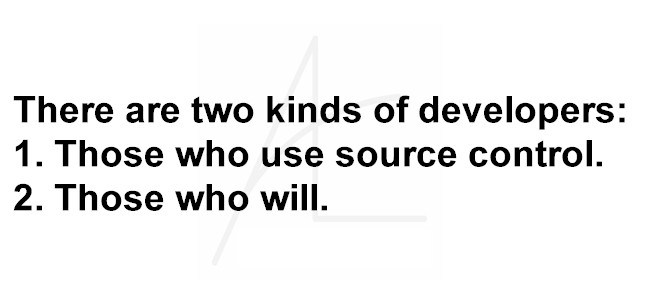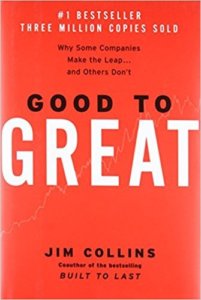 I’ve made statements about “two kinds of developers” for years. These statements are false inasmuch as all generalizations are false. The statements are not designed to be truisms. They are designed to make people think.
I’ve made statements about “two kinds of developers” for years. These statements are false inasmuch as all generalizations are false. The statements are not designed to be truisms. They are designed to make people think.
Last week – while presenting a full-day pre-conference session at the PASS Summit 2018 and again when delivering a session about Faster SSIS – I repeated the sentiment shown at the top of this post:
There are two kinds of developers:
1) Those who use source control; and
2) Those who will.
I follow up with: “Because if you do not use source control, you will lose code one day and it will break your heart.” Audience members laugh and the point is made.
More Than Two
There are myriad types of developers. And that’s a good thing. Why? Because there are myriad problems developers face in the wild and those problems need to be solved.
There are no one-size-fits-all solutions. If you attended the PASS Summit last week you likely saw some really cool demos. I know I did. And you may have thought – or even been told – that this, this right here is the answer for which you’ve searched your entire career.
There’s a possibility that the people selling you on whatever-this-is are absolutely correct.
There’s a greater possibility that they are less than absolutely correct.
I write this not to disparage anyone’s solution (or my own solutions). Promise.
I write this to dissuade the disparaging of anyone else’s solution (because that also happens).
The Bottom Line
Goldilocks. The bottom line is we all want the Goldilocks solution. We want the just-right solution that maximizes efficiency and minimizes complexity.
That’s just hard.
I can hear you thinking, “Why is maximizing efficiency and minimizing complexity hard, Andy?” I’m glad you asked. Solutions are a moving target, part art and part science, and the only way to learn where and when to draw the art-science line is experience.
A Moving Target
Maximizing efficiency and minimizing complexity is hard because it’s not at all the bottom line; it’s a line in the middle – a balancing of mutually-exclusive demands on your time, expertise, and energy.
Plus, it shifts.
Everything scales. Things scale either up and / or out or they scale down and / or in. In general (generality warning!), down and in is “bad” and up and out is “good.”
Experience Matters
Experienced architects understand subtle nuances; the art part of the art / science of enterprise software. When you speak with an experienced architect, you may hear her say, “It depends,” often. Good architects will finish the sentence and share at least some of the things upon which “it depends.” Less-experienced architects will present naked scalars and polarized advice.
Naked Scalars
Naked scalars are numeric values in a vacuum. They are unsupported because most are unsupportable. In other words, they are lies. Now, “lies” is a pretty harsh word. I prefer an engineering definition for the word “truth” that sounds an awful lot like the oath witnesses are asked to swear in US courts:
“Do you promise to tell the truth, the whole truth, and nothing but the truth, so help you God?”
This oath covers falsehoods that are shared, yes; but it also covers omissions of the truth.
Examples of naked scalars:
- “97% of engineers believe ____.”
- “10% of the people I know have practiced ____ successfully.”
Polarized Advice
Polarized advice can be a special case of naked scalars, advice focused on 0% and 100%. Polarized advice may or may not include scalars (naked or otherwise).
Examples of polarized advice:
- “I’ve never seen a good use case for ____.”
- “You should always ____.”
Are naked scalars and polarized advice always bad and wrong? Nope. That would be a generality (and we covered generalities already, did we not?).
Managing the Risk of Inexperience
What exactly is a consultant communicating when they engage naked scalars or polarized advice?
They are signalling a lack of experience.
They are, in effect, stating, “I do not have experience with ____.”
How do you manage the risk of inexperience?
You hire people – architects, especially – who understand there are good reasons systems are designed as they are. They will say things like, “I’m not sure why this was designed this way,” and mean it. It’s not a criticism; it’s an admission of curiosity. Trust me on this: You want curious consultants. They are more likely to identify a solution that solves the problem you are trying to solve in a way that doesn’t create new problems. Returning to the good reasons systems are designed as they are…
- Are (or were) the good reasons, well, good? Sometimes.
- Do the good reasons scale? Sometimes.
- Do the good reasons stand the test of time? Sometimes.
Good architects discern the baby from the bath water. Their experience separates good architects from the crowd. Not-as-good architects are less flexible, less willing to learn, and loathe to admit mistakes.
Let’s face facts, though: All architects and developers know what they know and don’t know what they don’t know. Better architects recognize these uncomfortable truths and mitigate them.
One way to mitigate inexperience – the best way, in my opinion, is to work with others.
The Story Of Us
At Enterprise Data & Analytics, our consultants and architects work together as a team. Our diverse group is a strength, bringing perspective to bear on the problems you are trying to solve. Our experience levels vary, the software and tools with which we work vary, and our demographics vary. As owner, I am honored to lead a team from diverse cultural – as well as diverse technical – backgrounds.
I didn’t set out to build a cultural- / age- / gender-diverse team. I set out to find the best people – to do what Jim Collins describes as “getting the right people on the bus.”
I found, though, that focusing on getting the right people on the bus had the side-effect of building a cultural- / age- / gender-diverse team.
As an added bonus, people of different genders approach problem-solving differently. People of different ethnicity pick up on stuff – especially cultural stuff, including enterprise culture – that people of other cultures miss.
EDNA‘s diversity is a strength that emerged unintentionally, but emerged nonetheless. As Chief Data Engineer, it’s very cool to watch our less-experienced consultants growing into more-experienced consultants and architects, while at the same time watching our people interact and perform as a team – each member catching stuff and contributing ideas because of their unique perspectives.
Cost Value
I can hear some of you thinking, “We’re on a budget here. Don’t good architects cost more than less-than-good architects, Andy?” I feel you. The answer is, “No. Good architects cost less than less-than-good architects.”
I can prove it. Because math. (Read that post for more information…)
It’s often accurate that good architects cost more per hour than less-than-good architects. Do you know why good architects charge more per hour?
Because they are worth more per hour.
(Generality!)
But consider this: “Time will tell” is a tried and true statement. Like good wine, the likelihood a generality is accurate improves with age. If enterprises continue to hire an organization – like Enterprise Data & Analytics or any other firm – to help them solve the problems they are trying to solve, then the folks shouting them down may be doing so in an effort to compete. Competition is fine, but I never hire anyone who talks bad about other clients or the competition. Why? They’ve demonstrated the capacity to talk bad about me at some later date.
Conclusion
I love our team!
I love our expertise!
I love our diversity!
I love that we always deliver value!
Contact me to learn more.
:{>


Comments